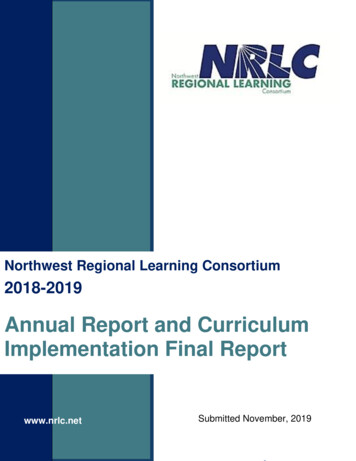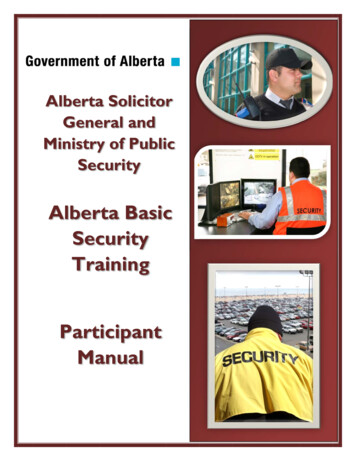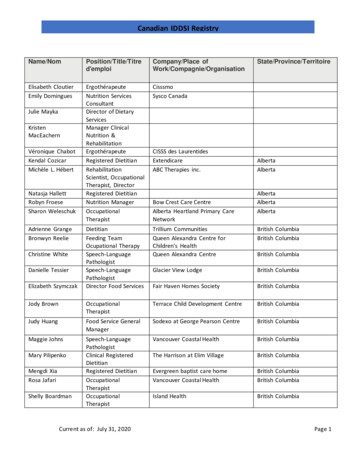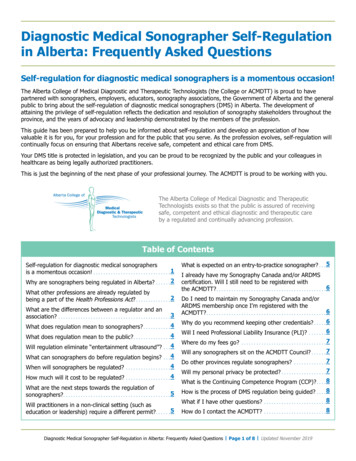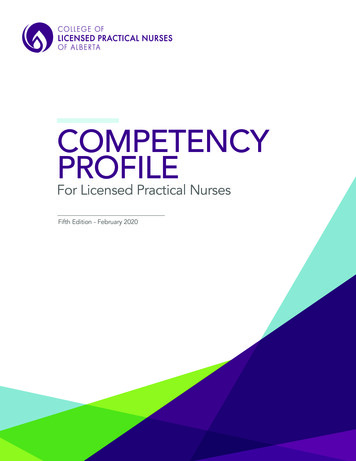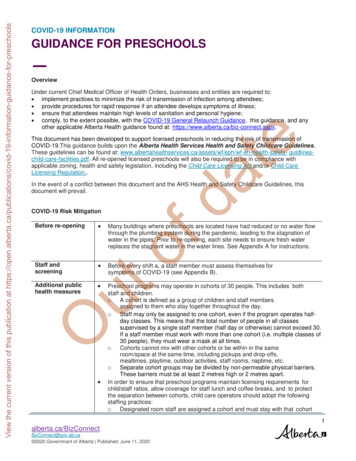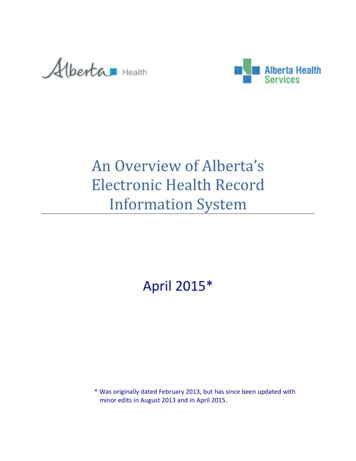
Transcription
An Overview of Alberta’sElectronic Health RecordInformation SystemApril 2015** Was originally dated February 2013, but has since been updated withminor edits in August 2013 and in April 2015.
CONTACTSAlberta HealthWendy RobillardDirector, HIA Policy, Privacy and Security21st Floor, Telus Plaza North Tower10025 Jasper Avenue NWEdmonton AB T5J 1S6Telephone: 780-422-5340Facsmilie : 780-422-1960E-mail: wendy.robillard@gov.ab.caAlberta Health ServicesMike TolfreeChief Privacy Officer10301 Southport Lane SWCalgary AB T2W 1S7Telephone: 403-943-0423Facsmilie : 403-943-0429E-mail: mike.tolfree@albertahealthservices.caAn Overview of Alberta’s Electronic Health Record Information System (EHRIS)-2-April 2015
TABLE OF CONTENTSCONTACTS 2TABLE OF CONTENTS . 3A.Summary . 61.B.Synopsis . 6INTRODUCTION . 71.Objectives . 72.What is the Alberta Electronic Health Record (EHR)? . 73.Background . 84.Current State Overview . 95.Vision for Future Development. 11C.a)Shared Health Record (SHR) . 11b)Personal Health Portal (PHP) . 12c)ePrescribing in the Pharmaceutical Information Network (PIN) . 12d)Laboratory Integration/Normalization . 13e)Cross-Enterprise Document Sharing (XDS) . 13f)eReferral . 13g)Pharmacy Practice Management Systems . 13ALBERTA EHR COMPONENTS PROFILES . 141.Access Tools . 14a)Alberta Netcare Portal (ANP) . 14b)Personal Health Portal (PHP) . 162.Registries . 17a)Person Directory (PD) . 17b)Provincial Client Registry (PCR) . 19c)Alberta Provider Directory (ABPD) . 20d)Provincial Provider Registry (PPR) . 21e)Delivery Site Registry (DSR) . 22f)AHS Client Registry (AHS CR, EMPI) . 243.Repositories . 25a)Pharmaceutical Information Network (PIN) . 25b)Netcare Clinical Repositories (NCR). 28An Overview of Alberta’s Electronic Health Record Information System (EHRIS)-3-April 2015
4.Infrastructure . 31a)Provincial Health Information Exchange (pHIE) . 31b)Identity and Access Management (IAM) System . 345.Other Networked Health Information Systems . 35a)Diagnostic Imaging (DI)/Provincial Picture Archiving and Communication System (ProvincialPACS) . 35b)D.Electronic Referral Systems . 35GOVERNANCE . 361.Health Information Act (HIA) . 36a)Custodianship and Information Manager Roles . 36b)The Office of the Information and Privacy Commissioner of Alberta (OIPC) . 372.Governance Structure . 37a)Minister of Health. 39b)EHR Data Stewardship Committee (EHRDSC) . 39c)Health Information Executive Committee (HIEC) . 39d)EHR Sponsors Committee . 40e)Personal Health Portal Steering Committee (PHPSC). 40f)Provincial Health Analytics Network Sponsors Committee (PHANSC) . 41g)IM/IT Strategy Committee . 41h)Health Information Standards Committee for Alberta (HISCA) . 413.EHR Governing Agreements and Programs . 41a)Information Exchange Protocol (IEP). 41b)Information Sharing Framework (ISF) . 424.E.Policy and Standards . 43a)Government of Alberta (GoA) . 43b)Alberta Health . 43c)Alberta Health Services (AHS). 43d)Health Professional Bodies (HPB) . 43PRIVACY AND SECURITY CONTROLS . 441.Privacy and Security Requirements Assessments and Processes . 44a)Privacy Impact Assessments (PIA) . 44b)Minimum Connectivity Requirements (MCR), Secure Connectivity Requirements (SCR) andTrusted Zones. 47c)2.Provincial Organizational Readiness Assessment (pORA) . 47Managing Deployment of Alberta EHR Systems . 48An Overview of Alberta’s Electronic Health Record Information System (EHRIS)-4-April 2015
a)Pre-Deployment Planning and Organization . 48b)Foundation and Readiness . 49c)Planning and Participation. 49d)Training and Implementation . 49e)Post-Implementation Support and Evaluation . 49f)Post-Deployment Maintenance. 503.Maintaining Alberta EHR Privacy and Security . 50a)Access Administrators (AA) . 50b)User Access Management (UAM). 51c)Authentication . 53d)Masking Patient Information . 53e)Auditing Access by Users . 55f)Provincial Reportable Incident Response Process (PRIRP) . 56g)Follow-up Remediation and Potential Consequences. 57h)System Change Management . 57i)Privacy and Security Training. 59F.CONCLUSION . 61G.APPENDICES . 62Appendix 1: Acronyms . 62An Overview of Alberta’s Electronic Health Record Information System (EHRIS)-5-April 2015
A. SUMMARY1. SynopsisThe Alberta Electronic Health Record (Alberta EHR) is the integrated provincial electronic healthinformation network that provides shared access to prescribed health information, by authorizedcustodians, in a secure environment. The scope of the Alberta EHR is limited to networked healthinformation systems for which Alberta Health is either the Information Manager or custodian.Alberta Health and Alberta Health Services (AHS) are jointly responsible for many of the e-healthsystems that comprise the Alberta EHR. This document, “An Overview of Alberta’s Electronic HealthRecord Information System”, was developed to summarize the Alberta EHR and the primary informationsystems which comprise it. For purposes of this document, Alberta EHR is also referred to as theAlberta Electronic Health Record Information System (EHRIS).Special Note:This document is intended to be an overview, high level, document which outlines the major componentsof the EHRIS. Many of the base level feeder systems and repositories are further explained in the PrivacyImpact Assessments which have been prepared by either Alberta Health Services or Alberta Health forthese major components.Many of the details, programs, linkages, infrastructure, technology, and underlying the systems areconstantly evolving. It is expected that this document may need to be updated as appropriate.An Overview of Alberta’s Electronic Health Record Information System (EHRIS)-6-April 2015
B. INTRODUCTION1. ObjectivesOne of the main objectives of creating a document like this is to explain, at a high level, the governancestructure, programs, mechanisms, and tools currently in place to ensure that all components of theAlberta EHR operate in compliance with the privacy, security and accountability standards of the HIA.This objective first of all requires a clear understanding of the components of the Alberta EHR in itscurrent state and how health information is collected, used and disclosed/transmitted among thesecomponents. The result is a comprehensive description of how Alberta EHRIS Privacy Governanceoperates as an integrated program providing custodians, information managers, patients and healthinformation regulators with a sound basis for evaluating and enhancing privacy governance into thefuture.2. What is the Alberta Electronic Health Record (EHR)?The Alberta EHR is defined in the Health Information Act (HIA) s. 56.1(a) as “the integrated electronichealth information system established to provide shared access by authorized custodians to prescribedhealth information in a secure environment.” By sourcing a wide network of health informationrepositories and tools the Alberta EHR presents a unified and comprehensive electronic health record onindividual patients to healthcare providers when they need it at the point of care. It is thereforedistinguished from an “electronic health record information system” as defined in the Alberta ElectronicHealth Record Regulation (EHR Regulation), s. 1(b), which represents the many individual applicationsand Electronic Medical Records (EMR) systems that may be in operation and limited to health careclinics or hospital facilities.Access to the Alberta EHR is typically granted through the Alberta Netcare Portal (ANP) to authorizedcustodians and their authorized affiliates to view patients’ prescribed health information that is housedin various Alberta Health repositories and registries, AHS clinical systems, and community site clinicalsystems. In some interfaces, such as System to System (S2S), access to the Alberta EHR is a directconnection between the Alberta Health and local systems. Some community pharmacies, for example,have S2S connection to the Pharmaceutical Information Network (PIN). In the future, more S2Sconnections will be deployed between community clinics and Alberta EHR repositories and registriesthrough the Shared Health Record (SHR) initiative.For the purpose of this overview, the scope of the Alberta EHR is limited to networked healthinformation systems for which Alberta Health is either the Information Manager or custodian, and thatare shared with other custodians in the Alberta health system. Repositories for which AHS orcommunity health service providers are the custodians, even if they are accessible to other custodians,are identified as sources for the Alberta EHR or as parallel health information systems but are notdescribed in detail.An Overview of Alberta’s Electronic Health Record Information System (EHRIS)-7-April 2015
3. BackgroundThe Alberta EHR provincial program began in 1997 with the establishment of Alberta Wellnet by AlbertaHealth with the mandate to develop and deliver province-wide EHR initiatives. This was the predecessorto the current Alberta Netcare program.In the spring of 1999, Alberta Wellnet implemented its first networked health information system, theSeniors Drug Program (SDP) in two Edmonton hospitals. The SDP System provided hospital staff,pharmacists and physicians caring for seniors 65 years and older to view their dispensed Alberta BlueCross Group 66 Plan medication information from a secure environment. This allowed medical staffaccess to accurate and complete information about their patients’ medications without relying solely onthe memory or notes provided by the patient or other staff. In the fall of 1999, the SDP was alsodeployed to hospital emergency rooms across Alberta.The SDP was replaced in 2001 with the PIN, which expanded its scope from seniors’ medicationinformation supplied by Alberta Blue Cross, to drug information on patients dispensed at communitypharmacies in Alberta.The HIA was proclaimed on April 25, 2001. The HIA set out the provisions for the collection, use,disclosure, access, and security standards for handling health information in health regions, pharmacies,nursing homes and government-funded healthcare services delivered by private healthcare providers,who were designated as “custodians”, under the HIA. The HIA required consent of individuals to disclosehealth information by “electronic means”, and both SDP and the PIN originally featured a patientelectronic means consent workflow as an integral system process. This provision in the HIA wasrepealed in 2002, and the consent process in the PIN was removed.The HIA also introduced the mandatory requirement for a PIA whenever a custodian planned toimplement a new administrative practice and information system relating to the collection, use, anddisclosure of individually identifying health information or a proposed change to those existing practicesor systems. Since that time, PIAs have become an essential component of the development of newAlberta EHR initiatives and systems.Also in 2001, the Alberta Medical Association (AMA) began operation of the Physician Office SystemProgram (POSP), which was part of a trilateral agreement between the AMA, the Regional HealthAuthorities (RHAs) and Alberta Health. This program provided funding and expert resources forphysicians to implement EMR systems in their private clinics, with the expectation that these couldeventually be linked to Alberta Health systems and become part of the Alberta EHR.The Provincial Personal Health Identifier (PPHI) initiative began in 2002, the first registry project of theAlberta EHR program. The PPHI led to the development of the Person Directory (PD) and later theProvincial Client Registry (PCR) to reliably and uniquely identify patients, a key feature of the AlbertaEHR.An Overview of Alberta’s Electronic Health Record Information System (EHRIS)-8-April 2015
To establish trusted zones when connecting to the Alberta EHR from within the former RHAs (now AHS),Alberta Health developed and funded the MCR and the SCR 2004 and SCR 2005 projects. The MCR andSCR projects were the implementation of the International Standards Code (ISO) 17799 Code of Practicefor Information Security Management. As a result of the these security assessments, Alberta Healthremoved the requirement for two-factor authentication when accessing Alberta Netcare from withinRegional Health Authority Information Technology (IT) networks.In 2003, Alberta Health implemented EHR-Release 1.0, also known as Portal 2004. The health regionsagreed to join with Alberta Health and AMA in 2004 to support a single, effective, common interjurisdictional EHR initiative for all users in the province. The Capital Health (CH) netCARE platform beganin 2004 and in March 2006, this Edmonton-based system was copied and adopted and became known asAlberta Netcare Portal 2006 (ANP 2006). In January 2008, ANP 2006 and CH-netCARE were completelymerged, creating a single system referred to as ANP.Alberta Health began delegating development of key source components of the Alberta EHR to healthregions in 2005, including laboratory and Diagnostic Imaging (DI) reporting and site and providerregistries. When the nine health regions merged to form AHS as the single health authority across theprovince in 2009, there was a renewed effort to integrate the separate regional networked healthinformation repositories into a province-wide system.By 2007, legislation was introduced requiring all community-based pharmacists to submit dispensinginformation to Alberta Health for inclusion in the PIN. Amendments to the HIA in 2010 expanded themandatory submission of health information to all custodians for a wide range of patient healthinformation. The EHR Regulation also formally established Alberta Health as the Information Managerof the Alberta EHR.In 2011, Alberta Health, in partnership with AHS, began pilot projects for the development of thePersonal Health Portal (PHP), under the branding of MyHealth.Alberta. The goal of this major newinitiative was to create a single trusted source for Albertans to find health information and useful healthtools among the countless internet sites available. In the fall of 2012, Alberta Health launched Release 3of the PHP, which introduces interactive communication and health monitoring between healthcareproviders and patients across the province.4. Current State OverviewThe Alberta EHR integrates and connects over fifty e-health systems, with various custodians andaffiliates contributing content and support services. In its current state, the Alberta EHR is comprised offour major components supporting the network in different ways:Access Tools - allow users to view health data across repositories and registries in the Alberta EHR, butdo not hold any data themselves.Registries - capture, store, and provide the authoritative source of data on places, identities, and eventsused by all repositories and access tools for identification purposes.An Overview of Alberta’s Electronic Health Record Information System (EHRIS)-9-April 2015
Repositories - capture, store and maintain various kinds of diagnostic, treatment, and care informationabout patients.Infrastructure - components that enable repositories, registries and access tools to connect and transmithealth data requested by users or other systems.Alberta Health and AHS are jointly responsible for many of the e-health systems that comprise theAlberta EHR.The governance of such a system presents a challenge to health care custodians, Information Manager’s,and regulators alike. To meet the objectives of this document in a more meaningful way, the diagrambelow (Figure 1) condenses the key components of the Alberta EHR documented above into a high levelAlberta EHR Network Overview.Figure 1Alberta EHR Network OverviewAn Overview of Alberta’s Electronic Health Record Information System (EHRIS)-10-April 2015
In the AHS Trusted Zone, regional integration engines combine data from selected AHS operationalsystems in Edmonton, Calgary and rural areas. The application of AHS registries (e.g. Enterprise MasterPatient Index (EMPI), Events Registry) ensures single, authoritative descriptions of patients, providers,sites and encounters. The EHR Index connects data to the correct individuals. Private community clinicscontribute laboratory and DI reports to this network.Health information from the AHS Trusted Zone is matched and exchanged with corresponding patientinformation in Alberta Health Trusted Zone registries (PCR, PD through the Provincial Health InformationExchange (pHIE). The pHIE acts like a router or hub that also connects pharmacies populating and usingthe PIN and, in the near future, physician clinic EMRs populating and using the SHR.With select repositories and registries in the AHS Trusted Zone and the Alberta Health Trusted Zonenetworked with many community healthcare services and clinics, the ANP and other points of access areable to access and present a comprehensive view of health information about a single individual from awide network of clinical and registry sources collecting or combining point-of-care information.5. Vision for Future DevelopmentContinuing development of the Alberta EHR focuses on the goal of “one person, one record” for theAlberta health system. The EHR IS Business Case completed as a companion document to Alberta 5-yearHealth System IT Plan (2011-2016) re-states the long-term vision for the Alberta EHRIS:“A fully integrated, unified and coordinated network of health information systems that supportsimproved care for Albertans by providing up-to-date information with the appropriate decision supporttools for health service providers and Albertans when they need it at the point-of-care.”In pursuit of this vision, Alberta Health, AHS and health stakeholders are working on the following keyinitiatives to develop and expand the Alberta EHRIS over the next five years.a) Shared Health Record (SHR)The SHR serves as an intermediary application that allows Netcare to provide information to localelectronic medical records systems (EMRs). It has no user interface of its own; it consists entirely ofmessaging standards used by Netcare and EMR applications. It will be implemented via limitedmodifications to Netcare and more significant enhancements to EMRs, initially those EMRs were fundedby the Physician Office System Program (POSP).Release 1 of the SHR adds the encounter information of patients held in local physician clinic EMRs topatient information currently available in Netcare which allows physicians to download transcribedreports from Netcare to their local EMR systems and to receive updates when those reports havechanged. Physicians may already incorporate transcribed reports into their EMR’s manually, but theSHR will simplify the process. The capture of clinical and administrative health service events inphysician office settings is a critical element of a patient’s longitudinal health record.An Overview of Alberta’s Electronic Health Record Information System (EHRIS)-11-April 2015
In addition, Release 1 of SHR will establish system-to-system (S2S) messaging interfaces betweencommunity clinics and Alberta EHR repositories and registries. This will allow seamless capture andaccess to Netcare data within clinic EMRs, starting with Qualified Service Providers (QSP) systemssupported through the POSP. System features will include propagating report updates and extendingGlobal Person-Level Masking (GPLM) of Netcare data to participating EMRs.The SHR Steering Committee on September 25, 2012 reduced the scope of the SHR project. Originally,the scope allowed for the delivery of encounter information from physician EMRs to Netcare. With thischange of scope, the SHR will not transfer any personal health information from EMR systems toNetcare, for Release 1. Should this scope change in subsequent releases, updates to the AHS NetcareClinical Repositories PIA – Shared Health Record Addendum will be completed and filed with the OIPCby AHS.AHS operates and maintains this system on behalf of Alberta Health, who is the Information Manager ofthis system.b) Personal Health Portal (PHP)Currently, Albertans using the PHP have access to information about Alberta programs and services,consumer health information, personal health information tools, and selected portal services, allcapturing only anonymous, aggregate data, via “MyHealth.Alberta”. As part of the PHP LimitedProduction Rollout, Alberta Health plans to implement interactive features capturing identifiablepersonal information, such as the Personal Health Record (PHR), which will provide patients with accessto some of their own personal health information in Alberta EHR systems, beginning with druginformation in the PIN. The PHR will also allow Albertans to create a record of their health information,to enter measurements and data from medical devices (e.g. blood glucose monitors, blood pressure) orto track therapeutic activities (e.g., as part of cardio exercise regimes) that can be made available totheir healthcare providers.c) ePrescribing in the Pharmaceutical Information Network (PIN)ePrescribing will replace paper or faxed prescription orders that will allow more timely and accurateprescription transactions. The PIN currently has ePrescribing functionality, but the status of digitalprescriptions in PIN as legal documents has been under review. A pilot to address ePrescribing iscurrently underway. This initiative will resolve that issue and encourage participating pharmacies andhealthcare providers to utilize the ePrescribing function. Alberta Health is the Information Manager ofthis system.An Overview of Alberta’s Electronic Health Record Information System (EHRIS)-12-April 2015
d) Laboratory Integration/NormalizationThis initiative will have the objective of standardizing terminology for laboratory test panels, orders, andresults to enhance the accuracy and usability of current laboratory information available in the AlbertaEHR. Although largely implemented by AHS and i
distinguished from an "electronic health record information system" as defined in the Alberta Electronic Health Record Regulation (EHR Regulation), s. 1(b), which represents the many individual applications and Electronic Medical Records (EMR) systems that may be in operation and limited to health care clinics or hospital facilities.

